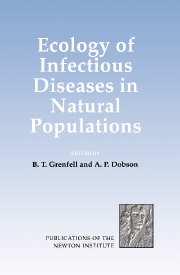Book contents
- Frontmatter
- Contents
- List of Participants
- Introduction
- BROAD PATTERNS AND PROCESSES
- Impact of Infectious Diseases on Wild Animal Populations: a Review
- Microparasites: Observed Patterns
- Mathematical Models for Microparasites of Wildlife
- Microparasite Group Report
- Macroparasites: Observed Patterns
- Mathematical Models for Macroparasites of Wildlife
- Macroparasite Group Report
- Critical Evaluation of Wildlife Disease Models
- PATHOGENS, INSECTS AND PLANTS
- IMPACT OF ECOLOGICAL AND GENETIC HETEROGENEITY
- Glossary
Mathematical Models for Macroparasites of Wildlife
Published online by Cambridge University Press: 22 January 2010
- Frontmatter
- Contents
- List of Participants
- Introduction
- BROAD PATTERNS AND PROCESSES
- Impact of Infectious Diseases on Wild Animal Populations: a Review
- Microparasites: Observed Patterns
- Mathematical Models for Microparasites of Wildlife
- Microparasite Group Report
- Macroparasites: Observed Patterns
- Mathematical Models for Macroparasites of Wildlife
- Macroparasite Group Report
- Critical Evaluation of Wildlife Disease Models
- PATHOGENS, INSECTS AND PLANTS
- IMPACT OF ECOLOGICAL AND GENETIC HETEROGENEITY
- Glossary
Summary
Introduction
The nature of macroparasitic infections
Parasites harm their hosts (Figure 1). That is one of the reasons we are interested in them. The notion that parasitism had some adverse effect on the mortality or fecundity of the host was an explicit part of Anderson and May's definition of the relationship (Anderson and May 1978), but is often attacked on the grounds that many host-parasite relationships seem to result in no discernable harm to the host. It is not difficult to find instances in the literature (usually case studies) in which individual animals or sometimes whole populations are found to have died as a result of infection with one or more species of parasite. Examples include dolphins and killer whales that have become stranded because nematode or trematode infections of the eustachian tube or cochlea have interfered with echolocation (Dailey and Ridgeway 1976, Stroud and Roffe 1979, Morimitsu et al. 1987); anaemia and pneumonia caused by excessively large nematode burdens resulting in the death of an opossum (Nettles, Prestwood and Davidson 1975); a similarly overwhelming trematode infection causing the death of a cougar (Kistner et al. 1979); and nematode infections as the cause of substantial mortality in populations of egrets and white tailed deer (Wiese et al. 1977, Davidson et al. 1980). Such instances are often dismissed as involving unusually high levels of parasitism or abnormal or aberrant hosts and are contrasted with those studies which report no discernable consequences of parasitism.
- Type
- Chapter
- Information
- Ecology of Infectious Diseases in Natural Populations , pp. 177 - 208Publisher: Cambridge University PressPrint publication year: 1995
- 18
- Cited by



